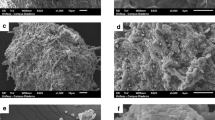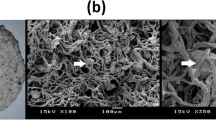Abstract
Effluents containing reactive dyes are globally generated in significant quantities as result of dyeing process applied to cellulosic fibers, frequently exhibiting elevates levels of dyes and inorganic salts. These textile effluents pose a substantial environmental concern due to their potential to induce eutrophication, impede photosynthesis, and even possess carcinogenic proprieties. This research endeavor aimed to address the treatment of intricate bichromatic effluents derived from an industrial dyeing process, which encompassed reactive dyes such as blue 19 (B-19), red 198 (R-198), and yellow 15 (Y-15) using two bio-based adsorbents: (1) yeast waste obtained from the ethanol industry after β-glucan removal from yeast biomass (YW), and (2) a nanomagnetic composite produced with YW and magnetite nanoparticles (YW-MNP). The concentrations of dyes in each binary mixture were quantified through the utilization of UV–Vis spectrophotometry and multivariate calibration, both prior and following the adsorption process. To evaluated the predictive capability partial least squares (PLS) and multivariate linear regression with variable selection via a successive projection algorithm (SPA-MLR), were employed, with PLS demonstrating the best predictive capacity. Langmuir isotherms yielded the best fit for YW and YW-MNP, respectively. Generally, YW exhibited higher dye removal compared to YW-MNP, attaining a maximum of 32% dye removal for bichromatic effluents under the physical–chemical conditions characteristic of effluent production.
Graphical abstract





Similar content being viewed by others
Data Availability
The datasets used and/or analyzed during the current study are available from the corresponding author upon reasonable request.
References
Abreu, R. E. L., Paz, J. E. M., Silva, A. C., Pontes, M. J. C., & Lemos, S. G. (2015). Ethanol fuel adulteration with methanol assessed by cyclic voltammetry and multivariate calibration. Fuel, 156, 20–25. https://doi.org/10.1016/j.fuel.2015.04.024
Al-Degs, Y., Khraisheh, M. A. M., Allen, S. J., Ahmad, M. N., & Walker, G. M. (2007). Competitive adsorption of reactive dyes from solution: Equilibrium isotherm studies in single and multisolute systems. Chemical Engineering Journal, 128(2–3), 163–167. https://doi.org/10.1016/j.cej.2006.10.009
Berradi, M., Hsissou, R., Khudhair, M., Assouag, M., Cherkaoui, O., El Bachiri, A., & El Harfi, A. (2019). Textile finishing dyes and their impact on aquatic environs. Heliyon, 5(11), e02711. https://doi.org/10.1016/j.heliyon.2019.e02711
Bezerra, K. C. H., Fiaschitello, T. R., Labuto, G., Freeman, H. S., Fragoso, W. D., da Costa, S. M., & da Costa, S. A. (2021). Reuse of water from real reactive monochromic and trichromic wastewater for new cotton dyes after efficient treatment using H2O2 catalyzed by UV light. Journal of Environmental Chemical Engineering, 9(4), 105731. https://doi.org/10.1016/j.jece.2021.105731
Cardona, D. S., Debs, K. B., Lemos, S. G., Vitale, G., Nassar, N. N., Carrilho, E. N. V. M., et al. (2019). A comparison study of cleanup techniques for oil spill treatment using magnetic nanomaterials. Journal of Environmental Management, 242, 362–371. https://doi.org/10.1016/j.jenvman.2019.04.106
Chong, K. H., & Volesky, B. (1995). Description of two-metal biosorption equilibria by Langmuir-type models. Biotechnology and Bioengineering, 47(4), 451–460. https://doi.org/10.1002/bit.260470406
Dada, A. O. (2012). Langmuir, Freundlich, Temkin and Dubinin-Radushkevich Isotherms studies of equilibrium sorption of Zn 2+ unto phosphoric acid modified rice husk. IOSR Journal of Applied Chemistry, 3(1), 38–45. https://doi.org/10.9790/5736-0313845
Debs, K. B., Cardona, D. S., da Silva, H. D. T., Nassar, N. N., Carrilho, E. N. V. M., Haddad, P. S., & Labuto, G. (2019). Oil spill cleanup employing magnetite nanoparticles and yeast-based magnetic bionanocomposite. Journal of Environmental Management, 230, 405–412. https://doi.org/10.1016/j.jenvman.2018.09.094
Gao, J.-F., Wang, J.-H., Yang, C., Wang, S.-Y., & Peng, Y.-Z. (2011). Binary biosorption of Acid Red 14 and Reactive Red 15 onto acid treated okara: Simultaneous spectrophotometric determination of two dyes using partial least squares regression. Chemical Engineering Journal, 171(3), 967–975. https://doi.org/10.1016/j.cej.2011.04.047
Henrard, D., Vuong, Q. L., Delangre, S., Valentini, X., Nonclercq, D., Gonon, M. F., & Gossuin, Y. (2019). Monitoring of superparamagnetic particle sizes in the langevin law regime. Journal of Nanomaterials, 2019, 1–9. https://doi.org/10.1155/2019/6409210
José, J. C., Debs, K. B., Labuto, G., & Carrilho, E. N. V. M. (2019). Synthesis, characterization, and application of yeast-based magnetic bionanocomposite for the removal of Cu(II) from water. Chemical Engineering Communications, 206(11), 1570–1580. https://doi.org/10.1080/00986445.2019.1615468
Koo, K. N., Ismail, A. F., Othman, M. H. D., Bidin, N., Rahman, A., & M. (2019). Preparation and characterization of superparamagnetic magnetite (Fe3O4) nanoparticles: A short review. Malaysian Journal of Fundamental and Applied Sciences, 15(1), 23–31. https://doi.org/10.11113/mjfas.v15n2019.1224
Kumari, K., & Abraham, T. (2007). Biosorption of anionic textile dyes by nonviable biomass of fungi and yeast. Bioresource Technology, 98(9), 1704–1710. https://doi.org/10.1016/j.biortech.2006.07.030
Kyzas, G. Z., Kostoglou, M., Lazaridis, N. K., & Bikiaris, D. N. (2013). Decolorization of dyeing wastewater using polymeric absorbents - an overview. In G. Melih (Ed.), Eco-Friendly Textile Dyeing and Finishing (1st ed.). InTechOpen, London. https://doi.org/10.5772/52817
Labuto, G., Cardona, D. S., Bugan Debs, K., Ribeiro Imamura, A., Hipólito Bezerra, K. C., & CarrilhoHaddad, E. N. V. M. P. S. (2018). Low-cost agroindustrial biomasses and ferromagnetic bionanocomposites to cleanup textile effluents. Desalination and Water Treatment, 112, 80–89. https://doi.org/10.5004/dwt.2018.21914
Labuto, G., Carvalho, A. P., Mestre, A. S., dos Santos, M. S., Modesto, H. R., Martins, T. D., et al. (2022). Individual and competitive adsorption of ibuprofen and caffeine from primary sewage effluent by yeast-based activated carbon and magnetic carbon nanocomposite. Sustainable Chemistry and Pharmacy, 28, 100703. https://doi.org/10.1016/j.scp.2022.100703
Labuto, G., & Carrilho, E. N. V. M. (2016). Bioremediation in Brazil: Scope and challenges to boost up the bioeconomy. In M. N. V. Prasad (Ed.), Bioremediation and bioeconomy (1st ed., pp. 569–588). Elsevier. https://doi.org/10.1016/B978-0-12-802830-8.00022-8
Mahmoud, M. S. (2016). Decolorization of certain reactive dye from aqueous solution using Baker’s Yeast ( Saccharomyces cerevisiae ) strain. HBRC Journal, 12(1), 88–98. https://doi.org/10.1016/j.hbrcj.2014.07.005
Marreto, P. D., Zimer, A. M., Faria, R. C., Mascaro, L. H., Pereira, E. C., Fragoso, W. D., & Lemos, S. G. (2014). Multivariate linear regression with variable selection by a successive projections algorithm applied to the analysis of anodic stripping voltammetry data. Electrochimica Acta, 127, 68–78. https://doi.org/10.1016/j.electacta.2014.02.029
Modesto, H. R., Lemos, S. G., dos Santos, M. S., Komatsu, J. S., Gonçalves, M., Carvalho, W. A., et al. (2021). Activated carbon production from industrial yeast residue to boost up circular bioeconomy. Environmental Science and Pollution Research, 28(19), 24694–24705. https://doi.org/10.1007/s11356-020-10458-z
Muralikrishna, I. V., Manickam, V. (2017). Wastewater treatment technologies. In I. V. Muralikrishna, & V. Manickam (Eds.), Environmental management (1st ed., pp. 249–293), Elsevier. https://doi.org/10.1016/B978-0-12-811989-1.00012-9
Nascimento, J. R., Bezerra, K. C. H., Martins, T. D., Carrilho, E. N. V. M., de A. Rodrigues, C., & Labuto, G. (2021). Textile effluent treatment employing yeast biomass and a new nanomagnetic biocomposite. Environmental Science and Pollution Research, 28(21), 27318–27332. https://doi.org/10.1007/s11356-021-12594-6
Pal, P. (2017a). Industry-specific water treatment. In P. Pal (Ed.), Industrial water treatment process technology (1st ed. pp. 243–511). https://doi.org/10.1016/B978-0-12-810391-3.00006-0
Pal, P. (2017b). Water treatment by membrane-separation technology. In Industrial Water Treatment Process Technology (pp. 173–242). Elsevier. https://doi.org/10.1016/B978-0-12-810391-3.00005-9
Prasad, M. N. V. (2015). Bioremediation and bioeconomy. (N. Prasad, Ed.) (1st ed., Vol. 1). Elsevier.
Pratt, A. (2014). Environmental applications of magnetic nanoparticles. In C. Binns (Ed.) Frontiers of nanoscience (1st ed. pp. 259–307). Elsevier. https://doi.org/10.1016/B978-0-08-098353-0.00007-5
Sajn, N. (2019). Environmental impact of the textile and clothing industry: What consumers need to know. EPRS: European Parliamentary Research Service. Retrieved from, https://policycommons.net/artifacts/1335345/environmental-impact-of-the-textile-and-clothing-industry/1941806/ on 31 Jan 2023. CID: 20.500.12592/7q9h36.
Samanta, K. K., Pandit, P., Samanta, P., & Basak, S. (2019). Water consumption in textile processing and sustainable approaches for its conservation. In S. S. Muthu (Ed.) Water in textiles and fashion consumption, footprint, and life cycle assessment (1st ed. pp. 41–59). Elsevier. https://doi.org/10.1016/B978-0-08-102633-5.00003-8
Senthil Kumar, P., Joshiba, G. J., Femina, C. C., Varshini, P., Priyadharshini, S., Arun Karthick, M. S., & Jothirani, R. (2019). A critical review on recent developments in the low-cost adsorption of dyes from wastewater. Desalination and Water Treatment, 172, 395–416. https://doi.org/10.5004/dwt.2019.24613
Shekoohiyan, S., Moussavi, G., Mojab, S., & Alahabadi, A. (2016). Adsorption of the reactive azo dyes onto NH4 Cl-induced activated carbon. Environmental Health Engineering and Management Journal, 3(1), 1–7.
Shukla, S., Khan, R., & Daverey, A. (2021). Synthesis and characterization of magnetic nanoparticles, and their applications in wastewater treatment: A review. Environmental Technology & Innovation, 24, 101924. https://doi.org/10.1016/j.eti.2021.101924
Suzaki, P. Y. R., Munaro, M. T., Triques, C. C., Kleinübing, S. J., Klen, M. R. F., de Matos Jorge, L. M., & Bergamasco, R. (2017). Biosorption of binary heavy metal systems: Phenomenological mathematical modeling. Chemical Engineering Journal, 313, 364–373. https://doi.org/10.1016/j.cej.2016.12.082
Thommes, M. (2010). Physical adsorption characterization of nanoporous materials. Chemie Ingenieur Technik, 82(7), 1059–1073. https://doi.org/10.1002/cite.201000064
Turabik, M. (2008). Adsorption of basic dyes from single and binary component systems onto bentonite: Simultaneous analysis of Basic Red 46 and Basic Yellow 28 by first order derivative spectrophotometric analysis method. Journal of Hazardous Materials, 158(1), 52–64. https://doi.org/10.1016/j.jhazmat.2008.01.033
Wang, F., Pan, Y., Cai, P., Guo, T., & Xiao, H. (2017). Single and binary adsorption of heavy metal ions from aqueous solutions using sugarcane cellulose-based adsorbent. Bioresource Technology, 241, 482–490. https://doi.org/10.1016/j.biortech.2017.05.162
Acknowledgements
The authors are grateful to FAPESP financial support (2016/06271-4 and 2020/14419-7), Biorigin Company (São Paulo, Brazil), NESPEQUI (Chemical Speciation Laboratory, Unifesp), NIPE (Núcleo de Instrumentação para Pesquisa e Ensino, Unifesp), LENCA (Laboratório de Engenharia e Controle Ambiental, Unifesp), SENAI (Serviço Nacional de Aprendizagem Industrial).
Funding
The source of funding for the research was reported in the acknowledgments item. The funding source did not play a role in the design of the study and in the collection, analysis and interpretation of data and in the writing of the manuscript. The financial support for the research process was mentioned in the acknowledgment item.
Author information
Authors and Affiliations
Contributions
Kátia C.H. Bezerra: preparation of textile effluents, writing the text, conducting experiments
Jacqueline R. Nascimento: conducting the experiments, processing the data and preparing the original figures.
Tiago D. Martins: treatment and discussion of adsorption kinetics data, writing—review and editing
Sherlan G. Lemos: chemometrisc analysis and discussions, writing—review and editing
Elma N.V.M. Carrilho: writing—review and editing
Christiane de A. Rodrigues: resources, writing—review and editing
Geórgia Labuto: conception and design of experimental work, resources, formal analysis, writing—original draft, writing—review and editing
Corresponding author
Ethics declarations
Ethical Approval
Not applicable.
Consent to Participate
Not applicable.
Consent for Publication
Not applicable.
Competing Interests
The authors declare no competing interests.
Additional information
Publisher's Note
Springer Nature remains neutral with regard to jurisdictional claims in published maps and institutional affiliations.
Supplementary Information
Below is the link to the electronic supplementary material.
Rights and permissions
Springer Nature or its licensor (e.g. a society or other partner) holds exclusive rights to this article under a publishing agreement with the author(s) or other rightsholder(s); author self-archiving of the accepted manuscript version of this article is solely governed by the terms of such publishing agreement and applicable law.
About this article
Cite this article
Bezerra, K.C.H., Nascimento, J.R., Martins, T.D. et al. Removal of Reactive Dyes from a Real Bichromatic Textile Effluent Employing Bio-Based Nanomagnetic Adsorbents. Water Air Soil Pollut 234, 438 (2023). https://doi.org/10.1007/s11270-023-06425-2
Received:
Accepted:
Published:
DOI: https://doi.org/10.1007/s11270-023-06425-2




